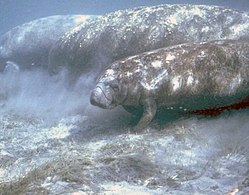Sirenians
| Sirenia Temporal range: Early Eocene-Holocene, 55.8–0 Ma |
|
|---|---|
 |
|
| West Indian manatees (Trichechus manatus) | |
| Scientific classification | |
| Kingdom: | Animalia |
| Phylum: | Chordata |
| Class: | Mammalia |
| Superorder: | Afrotheria |
| Clade: | Paenungulata |
| Clade: | Tethytheria |
| Order: |
Sirenia Illiger, 1811 |
| Families | |
| Synonyms | |
|
List of synonyms
|
|
Dugongidae
Trichechidae
†Prorastomidae
†Protosirenidae
Sirenia, commonly referred to as sea cows, is an order of fully aquatic, herbivorous mammals that inhabit swamps, rivers, estuaries, marine wetlands, and coastal marine waters. Sirenia comprises the families Dugongidae (the dugong), Trichechidae (manatees), †Protosirenidae (Eocene sirenians), and †Prorastomidae (terrestrial sirenians). There are currently four extant species of sirenians. Sirenians are classified in the clade Paenungulata, alongside the elephants and the hyraxes, and evolved in the Eocene 50 million years ago. The Dugongidae diverged from the Trichechidae in the late Eocene or early Oligocene.
Sirenians get to be between 2.5 and 4 metres (8.2 and 13.1 ft) in length and 1,500 kilograms (3,300 lb) in weight. The now extinct †Steller's sea cow was the largest sirenian to have lived, and could reach lengths of 8 metres (26 ft) and weights of 8 to 10 metric tons (8.8 to 11.0 short tons). Sirenians have a large, body to prevent drag through the water. They have heavy bones that act as ballasts to counteract the buoyancy of their blubber. They have a thin layer of blubber and subsequently are sensitive to temperature fluctuations, which causes migrations when the water temperature dips too low. Sirenians are slow-moving, typically coasting at 8 kilometres per hour (5.0 mph), however they can reach 24 kilometres per hour (15 mph) in short bursts. Sirenians use their strong lips to pull out seagrasses, consuming 10–15% of their body weight per day. While breathing, sirenians hold just their nostrils above the surface, sometimes standing on their tail to do so. Sirenians typically inhabit warm, shallow, coastal waters or rivers. They are mainly herbivorous, but have been known to consume animals such as birds and jellyfish. Males typically mate with more than one female (polygyny), and may participate in lek mating. Sirenians are K-selectors, and display parental care.
...
Wikipedia
